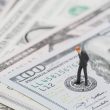by Ryan McCormack, QQQ Equity ETF Strategist, Invesco Ltd., Invesco Canada
Whether markets are up or down, innovation is ongoing
Necessity is the mother of invention. Perhaps the greatest modern example occurred in 1970 when the Apollo 13 astronauts created a carbon dioxide scrubber out of socks, duct tape and a few other random parts floating about their cabin.1 But isn’t necessity a close cousin of adversity? The Dow just closed the book on its worst first quarter in 124 years2 – if adversity has the potential to generate creative thinking, can we be expecting a burst of new inventions, businesses and services in the coming months? History suggests the answer is yes.
When the going gets tough…
There is nothing like the prospect of imminent disaster to focus the mind. Suddenly, the impossible becomes not just possible, but essential like oxygen. A great economy can be the high tide that floats all boats via flush consumers, business investment, available credit and more. But in the absence of good times, innovation can still flourish (because it has to). Products like Toll House cookies, Kraft Miracle Whip, Scotch Tape, the iPod and Diet Coke were introduced during recessions and are now part of our daily lives.3 And iconic brands like Burger King, CNN, Fedex, IBM, Microsoft and Walt Disney Productions were all launched in challenging economic times.4 We can leave the question of whether we are currently in a recession to the experts, but during recent downturns there was also a burst of innovation. Here are three companies that were born of necessity during a U.S. recession – all are now known innovators and listed on the Nasdaq exchange.
The birth (and rebirth) of Netflix
Late fees. Remember those (and how we despised them)? Netflix was born after eventual co-founder Reed Hastings was fined US$40 in 1997 for his (very) late return of a VHS copy of Apollo 13 to Blockbuster Video.5 Whether this story is actually true or not, it’s one thing to be incensed by a perceived injustice, but quite another to do something constructive about it. The problem faced by co-founders Hastings and Marc Randolph was weight. Not their belt sizes, but the weight of VHS videotapes. In order to start a company with no late fees, the numbers would have to make sense. VHS tapes were expensive and fairly bulky at that time and could not make the trip to a customer’s house and back via mail at a reasonable cost. DVDs were new but much more compact – might these be the answer? The pair decided on an experiment. Randolph went to a used record store and bought a Patsy Cline CD, removed it from its case and sent it to Hastings in a regular envelope inside a greeting card. It only cost 32 cents to mail, so if it arrived intact the idea had a chance. It arrived the next day undamaged.
Rebirth through streaming
By the mid-2000s, the availability and capacity of consumer bandwidth had grown to the point where streaming (i.e., watching/listening to internet content in real time) was a legitimate alternative to mailing DVDs back and forth. Netflix decided to test the waters and began allowing customers to stream movies on their PCs for free. This promotional effort was (either by luck or design) perfectly timed. It coincided with an explosion in personal electronics use due to the falling cost (and rapidly increasing capacity) of the internet during a period when consumers had the economic jitters. Netflix pounced. In 2008, streaming was made available on popular items like the Xbox 360, Blu-ray disc players and TV set-top boxes. The following year, this access was expanded to include the Sony PS3, internet-connected TVs and other devices, followed by the Nintendo Wii and Apple products. In 2010, Netflix launched its service in Canada and by 2016 was available worldwide. Currently, the company has nearly 170 million subscribers, a market cap of around US$160 billion and is part of the Nasdaq-100 Index.6
Tesla – when is a car company not a car company?
Everyone has heard of Tesla and its current CEO, the enigmatic and brilliant Elon Musk. But what is Tesla? Is it a car and truck manufacturer, or is it a utility attempting to expand the U.S. power grid? Is it a power generation and storage play, or merely a division existing alongside other widely divergent (space transportation, tunneling, etc.) businesses like GE? If you asked the CEO, he might say that Tesla is a software company that builds premium devices for consumers and businesses. This approach may actually be more similar to Apple than (for example) General Motors in that premium products are introduced to a small but receptive audience of early adopters, followed by a gradual move into larger markets using lower price points.
Applying the Apple model
Tesla was born in 2003 as the vision of several engineers who believed electric vehicles could be competitive with those traditionally powered, while helping the world transition to a greener future. It took five years and four rounds of venture capital funding to roll out the first Tesla for sale to the public. Called the Roadster, it was introduced in early 2008 in the middle of the global financial crisis. With a base price of US$109,000, one might think the timing of this launch was less than optimal, but the Roadster was not a mass-market vehicle. It was a tease for technophiles of the automotive world, and it worked. Using the experience gained from four years of manufacturing (and utilizing the funds and patience of 2,400+ early adopter-buyers), Tesla introduced the Model S (starting at US$57,400) in June 2012 and quickly ramped up production. After selling 2,653 in the second half of 2012, Tesla delivered over 22,000 in 2013, nearly 32,000 the next year and more than 50,000 in 2015.7 Last year, Tesla sold over 367,000 vehicles at all price points and became the largest electric car maker in the world.8 By applying the software release model to auto manufacturing and continuously updating its vehicles, Tesla turned the industry on its head while achieving a market cap of US$83 billion.9
Adobe – if Steve Jobs makes an offer, you know you’re getting warm
Some brilliant inventions come about due to complaints from consumers or the needs of businesses. Adobe was launched to solve a problem that the general public knew nothing about. Back in 1982 while working for Xerox at its (now legendary) Palo Alto Research Center, John Warnock and Charles Geschke thought they had something – a programming language designed to mathematically describe the precise position, shape, and size of objects on a computer-generated page. Because it used math, it was not tied to any particular computer product. This was long before the advent of personal computing, but the two scientists knew that using their new language (later called PostScript) would allow any computer or similar device to read and replicate anything it described in precise terms. Xerox decided against marketing the language, so Warnock and Geschke formed their own company (initially in Warnock’s garage), naming it Adobe after the creek that ran behind the house.10
The company you keep
Steve Jobs saw the potential for this new language and offered US$5 million for the company.11 The pair, more confident than ever, turned him down but accepted an investment for a minority interest. With these funds, Warnock and Geschke considered branching out into other related businesses but ultimately decided to focus on perfecting and expanding their printing software and digital fonts. In just five years, PostScript had become the de facto standard printer language, with more than 400 third-party software programs and licensing agreements with 19 printer companies across the globe.12 Their product also provided the fuel to launch what would become the desktop publishing industry, and Adobe wasted no time. The company introduced Illustrator in 1987 and Photoshop in 1990, cementing its leadership within this fledgling industry. Adobe continued to grow through innovation and acquisitions and by the mid-90s, had invented yet another blockbuster – the portable document format (pdf) for sharing electronic documents. Adobe jump-started acceptance of pdfs by distributing its reader program for free. Today, Adobe has over 22,000 employees worldwide, 2019 sales exceeding US$11 billion and a current market cap of about US$164 billion.13
Growth and innovation in turbulent times
These are just three stories of spectacular success born during times of great adversity. Across the Nasdaq-100 Index, there are many more. By applying equal parts brainpower, ingenuity and guts, these entrepreneurs have created sustainable, global brands that have totally disrupted the status quo. It may be difficult to even consider the future of investing at this moment in history but consider this – a 2009 study sponsored by the Kauffman Foundation found more than half of the (then) current Fortune 500 companies were launched during a recession or bear market.14 Who knows what big ideas are brewing right now?
This post was first published at the official blog of Invesco Canada.
















